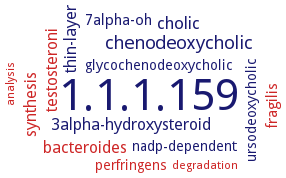1.1.1.159: 7alpha-hydroxysteroid dehydrogenase
This is an abbreviated version!
For detailed information about 7alpha-hydroxysteroid dehydrogenase, go to the full flat file.

Word Map on EC 1.1.1.159 
-
1.1.1.159
-
chenodeoxycholic
-
cholic
-
testosteroni
-
bacteroides
-
thin-layer
-
3alpha-hydroxysteroid
-
synthesis
-
fragilis
-
7alpha-oh
-
glycochenodeoxycholic
-
nadp-dependent
-
ursodeoxycholic
-
perfringens
-
degradation
-
analysis
- 1.1.1.159
-
chenodeoxycholic
-
cholic
- testosteroni
- bacteroides
-
thin-layer
-
3alpha-hydroxysteroid
- synthesis
- fragilis
-
7alpha-oh
-
glycochenodeoxycholic
-
nadp-dependent
-
ursodeoxycholic
- perfringens
- degradation
- analysis
Reaction
Synonyms
7-alpha-HSDH, 7-HSDH, 7alpha-HSD, 7alpha-HSDH, 7alpha-hydroxy steroid dehydrogenase, 7alpha-hydroxysteroid dehydrogenase, Bile acid-inducible protein, CA 7alpha-HSDH, Ca7alpha-HSDH, dehydrogenase, 7alpha-hydroxy steroid, J-1-1, NADP(H)-dependent 7alpha-HSDH, NADP(H)-dependent 7alpha-hydroxysteroid dehydrogenase, NADP+-dependent 7alpha-HSDH, nicotinamide adenine dinucleotide phosphate-dependent 7alpha-hydroxysteroid dehydrogenase
ECTree
Advanced search results
Engineering
Engineering on EC 1.1.1.159 - 7alpha-hydroxysteroid dehydrogenase
Please wait a moment until all data is loaded. This message will disappear when all data is loaded.
C260S
the mutant shows 2fold higher specific activity as compared to the wild type enzyme
L26M
the mutant shows 1.26fold higher specific activity as compared to the wild type enzyme
Q255L
the mutant shows 4.2fold higher specific activity as compared to the wild type enzyme
Q255L/C260S
the mutant shows 6.5fold higher specific activity and exhibits 10fold higher and 14fold higher catalytic efficiencies toward chenodeoxycholic acid and NADP+, respectively, as compared to the wild type enzyme. The mutant also displays significantly enhanced tolerance in the presence of high concentrations of substrate compared to the wild type
Q255R
the mutant shows 1.3fold higher specific activity as compared to the wild type enzyme
R16A
the mutant shows reduced catalytic efficiency compared to the wild type enzyme
R16A/R194A
the mutant shows reduced catalytic efficiency compared to the wild type enzyme
R16G
site-directed mutagenesis, kcat and Km of the R16G mutant increase by more than 4times and 5times compared with wild-type values, respectively, while the catalytic efficiency (kcat/Km) of R16G mutant decreases by 17.26% compared to the wild-type enzyme. The increase in Km indicates that affinity of R16G mutant toward NADP+ becomes weak, while the cofactor NADP(H) dissociates more easily from the binding site resulting in the increase in kcat
R194A
mutant with increased catalytic efficiency toward NADP+, as compared to the wild type enzyme
R194G
site-directed mutagenesis, the mutant shows slightly reduced catalytic efficiency compared with NADP+ compared to the wild-type enzyme
T15A
the catalytic efficiency of the mutant decreases by more than 4.5times, compared to the wild type and the affinity drops dramatically (Km value increases by nearly 17times)
T15A/R16A/R194A
the mutant shows strongly reduced catalytic efficiency compared to the wild type enzyme
C260S
Clostridium sardiniense DSM 1599
-
the mutant shows 2fold higher specific activity as compared to the wild type enzyme
-
L26M
Clostridium sardiniense DSM 1599
-
the mutant shows 1.26fold higher specific activity as compared to the wild type enzyme
-
Q255L
Clostridium sardiniense DSM 1599
-
the mutant shows 4.2fold higher specific activity as compared to the wild type enzyme
-
Q255L/C260S
Clostridium sardiniense DSM 1599
-
the mutant shows 6.5fold higher specific activity and exhibits 10fold higher and 14fold higher catalytic efficiencies toward chenodeoxycholic acid and NADP+, respectively, as compared to the wild type enzyme. The mutant also displays significantly enhanced tolerance in the presence of high concentrations of substrate compared to the wild type
-
Q255R
Clostridium sardiniense DSM 1599
-
the mutant shows 1.3fold higher specific activity as compared to the wild type enzyme
-
additional information
-
development and evaluation of a selected multi-step reaction system for the synthesis of ursodeoxycholic acid, separation of each step by isolation of the intermediates using ultrafiltration membranes, overview
additional information
generation of a C-terminaly truncation enzyme mutant. When 2 and 6 amino acids of C-terminal are removed, the catalytic efficiency of Ca7alpha-HSDH remains 19.1% and 2.5%, respectively. No activity remains after deletion of 8, 14 and 17 amino acids
additional information
-
generation of a C-terminaly truncation enzyme mutant. When 2 and 6 amino acids of C-terminal are removed, the catalytic efficiency of Ca7alpha-HSDH remains 19.1% and 2.5%, respectively. No activity remains after deletion of 8, 14 and 17 amino acids
additional information
construction of a 7alpha -HSD knockout mutant that shows decreased degradation of testosterone, estradiol and cholesterol compared to the wild-type
additional information
-
construction of a 7alpha -HSD knockout mutant that shows decreased degradation of testosterone, estradiol and cholesterol compared to the wild-type
additional information
-
construction of a 7alpha -HSD knockout mutant that shows decreased degradation of testosterone, estradiol and cholesterol compared to the wild-type
-
additional information
-
development and evaluation of a selected multi-step reaction system for the synthesis of ursodeoxycholic acid, separation of each step by isolation of the intermediates using ultrafiltration membranes, overview
additional information
-
development and evaluation of a selected multi-step reaction system for the synthesis of ursodeoxycholic acid, separation of each step by isolation of the intermediates using ultrafiltration membranes, overview
additional information
-
development and evaluation of a selected multi-step reaction system for the synthesis of ursodeoxycholic acid, separation of each step by isolation of the intermediates using ultrafiltration membranes, overview


 results (
results ( results (
results ( top
top






